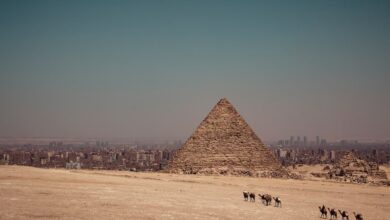The Palm Dubai, UAE
The Palm is a group of islands located in Dubai. The three islands include Jumeirah, Jebel Ali, and Deira. Established in 2001, the islands are still work in progress with more than 28 hotels already completed. The project has been largely financed by petroleum proceeds.
The aerial view of Palm Jumeirah is one of the most captivating scenes here. It looks like a palm tree surrounded by a circle that forms a picturesque view.
You can use a taxi from Nakheel metro station to get there, or from Dubai Internet city. There are many tour operators offering transport services to this destination.

Aqueduct of Segovia, Segovia, Spain
Aqueduct of Segovia is a UNESCO World heritage site located in the province of Segovia, Spain. It remains one of the most preserved sites in the country and a major tourist attraction.
The scene is so much treasured that it appears in Segovia’s coat of arms. Besides, it is easy to get to this destination from Madrid. You can either travel by bus or train. The beautiful scenery offers a great background for photography. You’ll also take home history lessons from here.
Great Wall of China, Beijing
The easiest route to this destination is from the Beijing International airport. Several taxis and buses transport tourists to this beautiful and historical wall to and from the airport.
The long wall was built with for the country’s defense purposes. Besides, the many towers along help with border and migration controls. The aerial view of the wall is also a mind-blowing scene you’ll love to see.
Some of the activities people do at the Great wall of china includes hiking, camping, picnics, wall marathon, and have fun at the roller coaster. This a great place to make memories with friends and family.

Taj Mahal, Agra, India
You can get to this destination from New Delhi via bus. The ivory white marble museum is located right on the bank of river Yamuna. The beautiful building receives close to 8 million visitors a year and sits on a 17 Ha piece of land.
Taj Mahal was built in the 17th century and was opened in 1648. The mausoleum continues to attract visitors from all over the world with its captivating scenes. Restaurants are also available here offering amazing food for the tourists.
Trans-Siberian Railway, Russia
The Trans-Siberian railway connects Russia’s East to the West. The railway line is about 9,300 km long and runs from Moscow to Vladivostok. This journey may cost you $1600 traveling from the Capital to the Pacific Ocean in Vladivostok.
There are amazing touristic opportunities in between the two destinations. Owned by Russian Railways, be sure to see beautiful sceneries en route.
The railway is one of the best engineering marvels in the world and runs on two tracks. The Mongolian steppe, the Great wall of China, Moscow’s Red Square, and Kazan are some of the beautiful destinations you can use this train service to get to.
Burj Khalifa, Dubai, UAE
This is one of the most popular skyscrapers in the world. The building has 163 floors and its construction commenced in 2004. Owned by Emaar Properties, Burj Khalifa continues to make millions from the many visitors that make their way to this place.
Thursdays, Fridays, and Saturdays are the busiest days with Sunday and Monday less busy. The entry fee is affordable meaning value for money is a guarantee. The views and picturesque background here make it an amazing place for photography.
The Burj Khalifa park, Dubai Mall, Aquarium, Ice Rink, and SEGA republic are some of the attractions in and around the skyscraper you could spend your time at.

Akashi Kaikyo Bridge, Akashi Strait, Japan
This suspension bridge links Kobe and Awaji island. The six lane bridge crosses Akashi Strait and is almost 4 km long. The Satoshi Kashima designed bridge was completed in 1998 and opened on April 5 the same year.
Close to 23,000 vehicles cross the bridge daily. That makes enough revenue for the management to clear the debt used to finance the bridge’s construction.
The bridge is just a short drive from Kobe airport. It also offers an amazing view and a fine place to create memories.
White Pass and Yukon Route Railroad, Canada
This railroad joins Skagway port and Yukon capital. Owned by TWC enterprises, the pass was opened in 1900 and closed in 1982. 6 years later, The White Pass railway was reopened.
It is 107 miles and not connected to any railroad. That is why it is considered an isolated railroad system.
The historic landmark is not only a transport system but also offers a pass to excursions. You can travel using the rail to different excursion points starting from Fraser British Columbia. The easiest route the White Pass and Yukon route railroad is from the Vancouver airport.
Tokyo Sky Tree, Tokyo
The Tokyo Sky Tree is a broadcast and observation tower with beautiful restaurants for visitors. The skyscraper was open on 22 May 2012 after its completion three months before. It costed 65B Japan Yen and continues to receive tourists from all over the world.
The marvel is owned by Tobu Railways and has an antenna spore of 634m. Besides, it has 32 floors above the ground and an additional 3 below. Also, the building has 13 elevators to allow visitors move up and down the tower swiftly. It’s only 14 minutes to get here from the Asakusa railway station using the Tokyo Metro Ginza Line.
International Space Station
Launched in November 1998, the International Space Station has a mass of about 440,000kg and 73m long. With an orbital speed of 7.66 km/s, the multinational project involves several governments and organizations.
The research center is beyond human imagination and provides a place out of earth for life inhabitation. You need astrological qualifications and a rocket to get to this place. The station has a crew of 7 and makes about 15 orbits in a day.
The international Space Station remains one of the man’s greatest engineering inventions.




